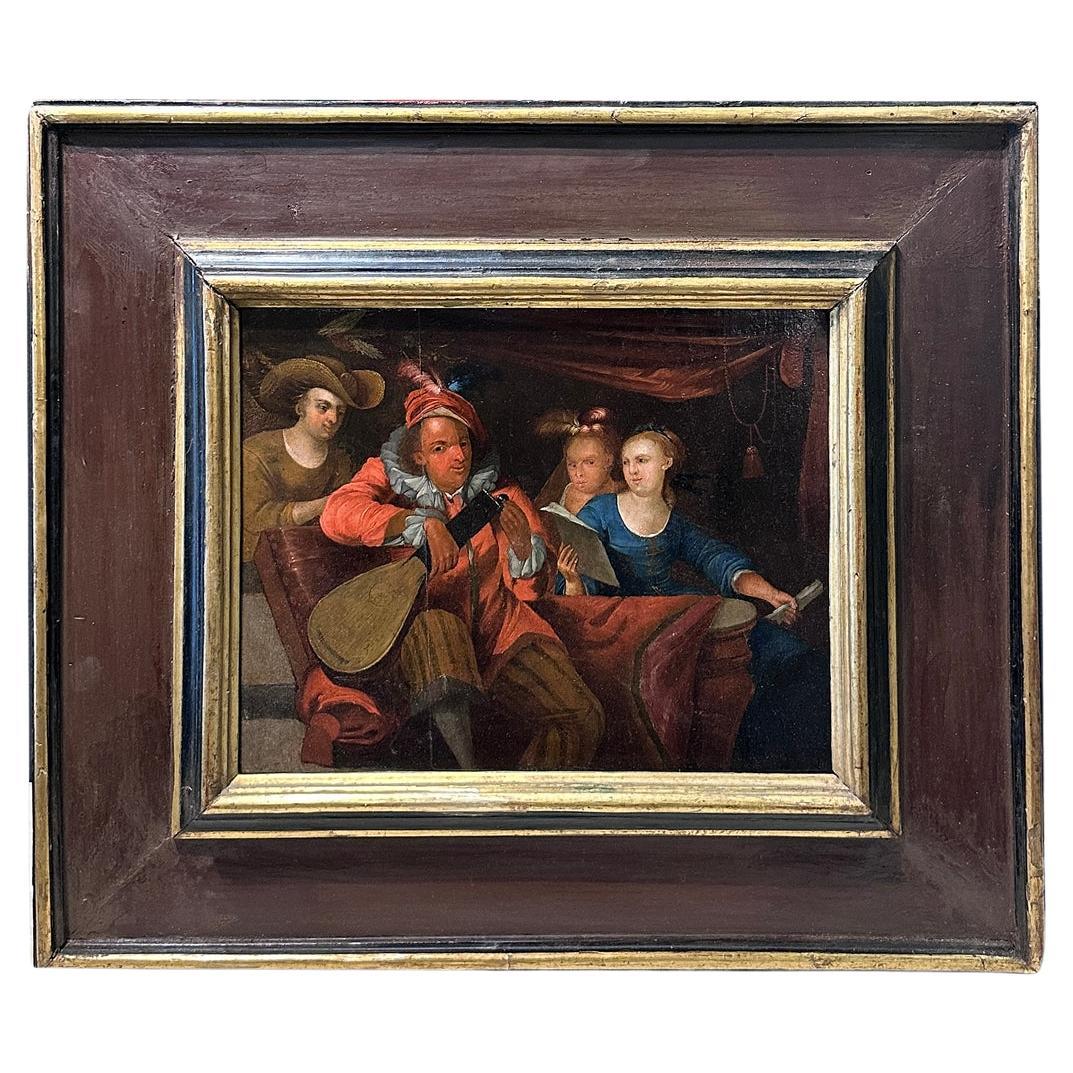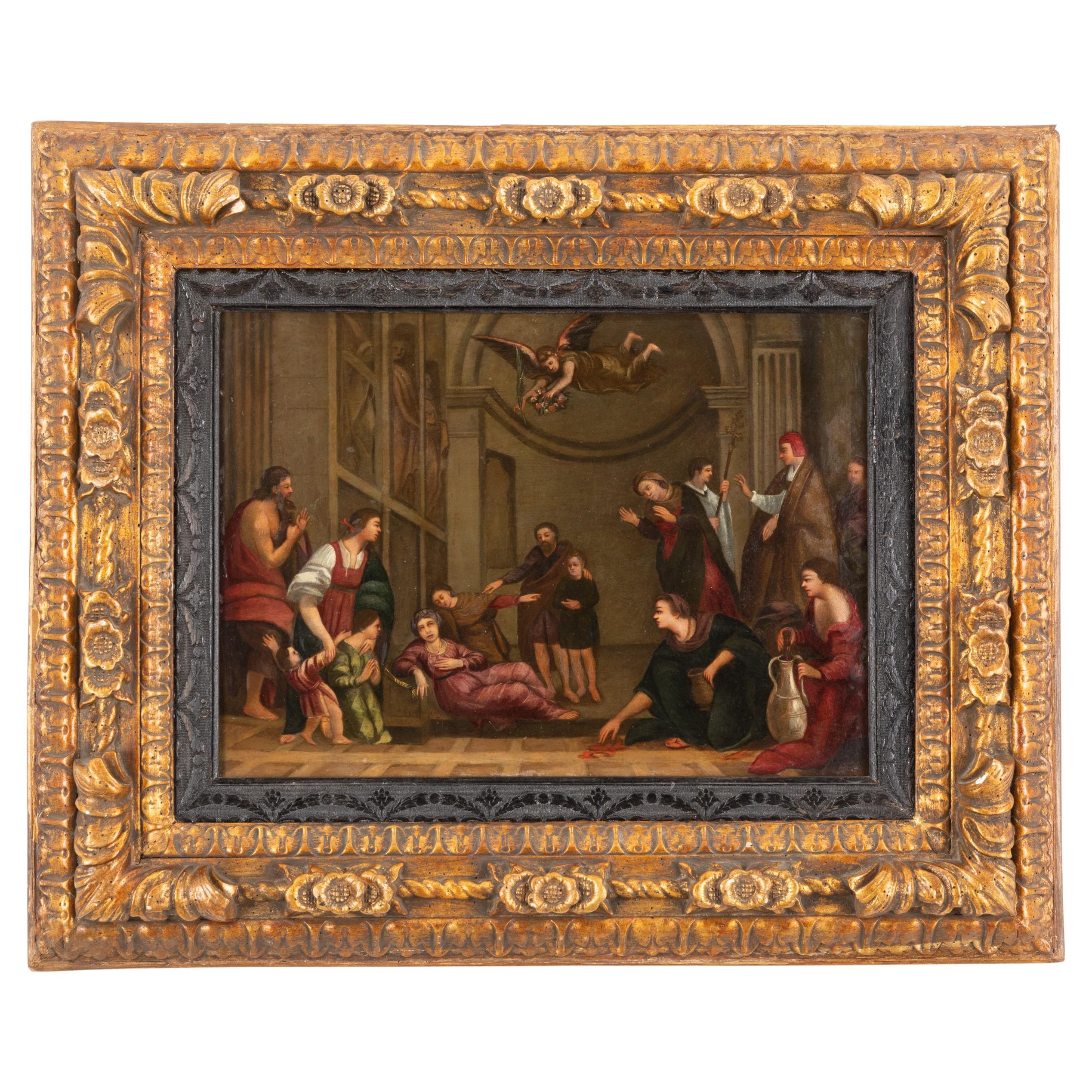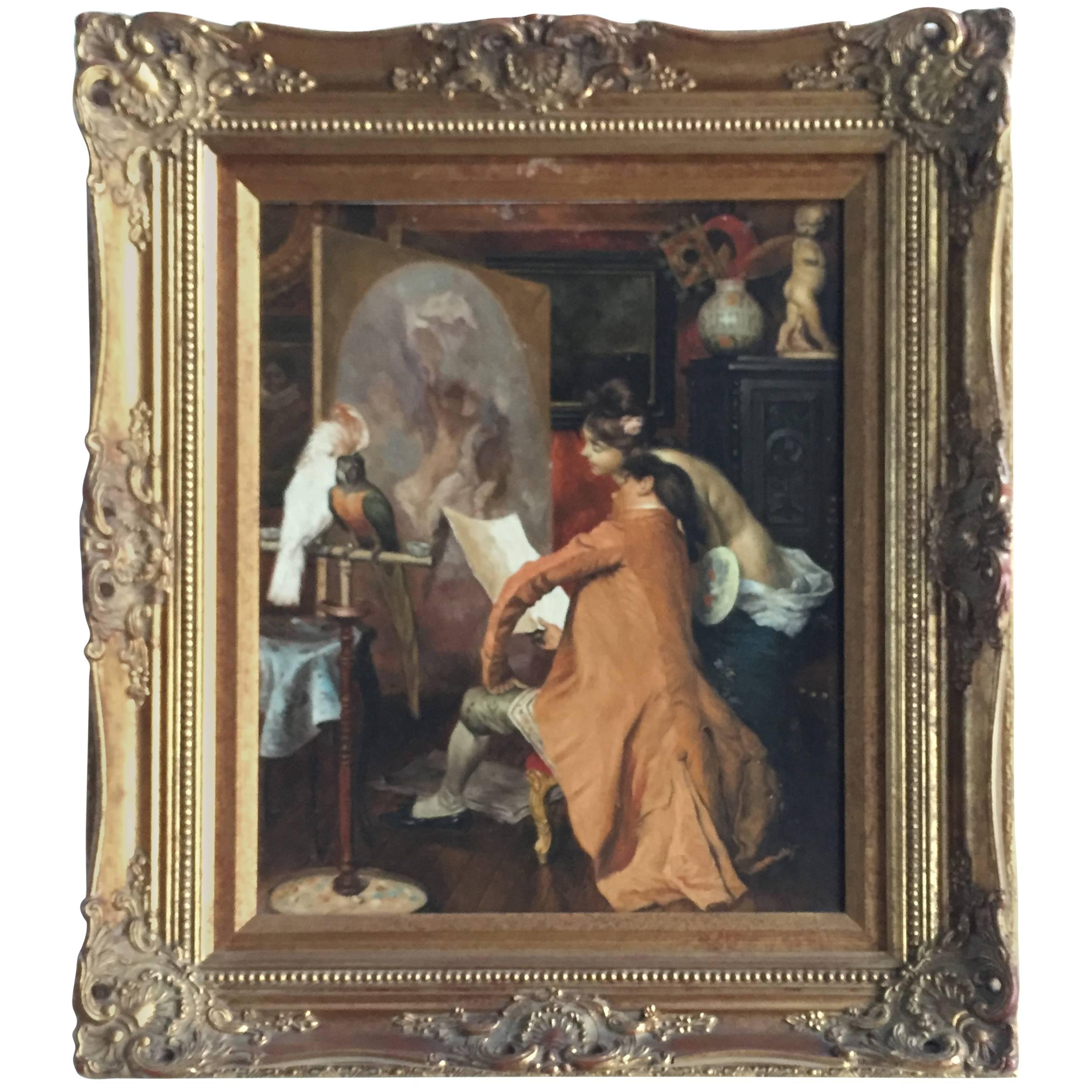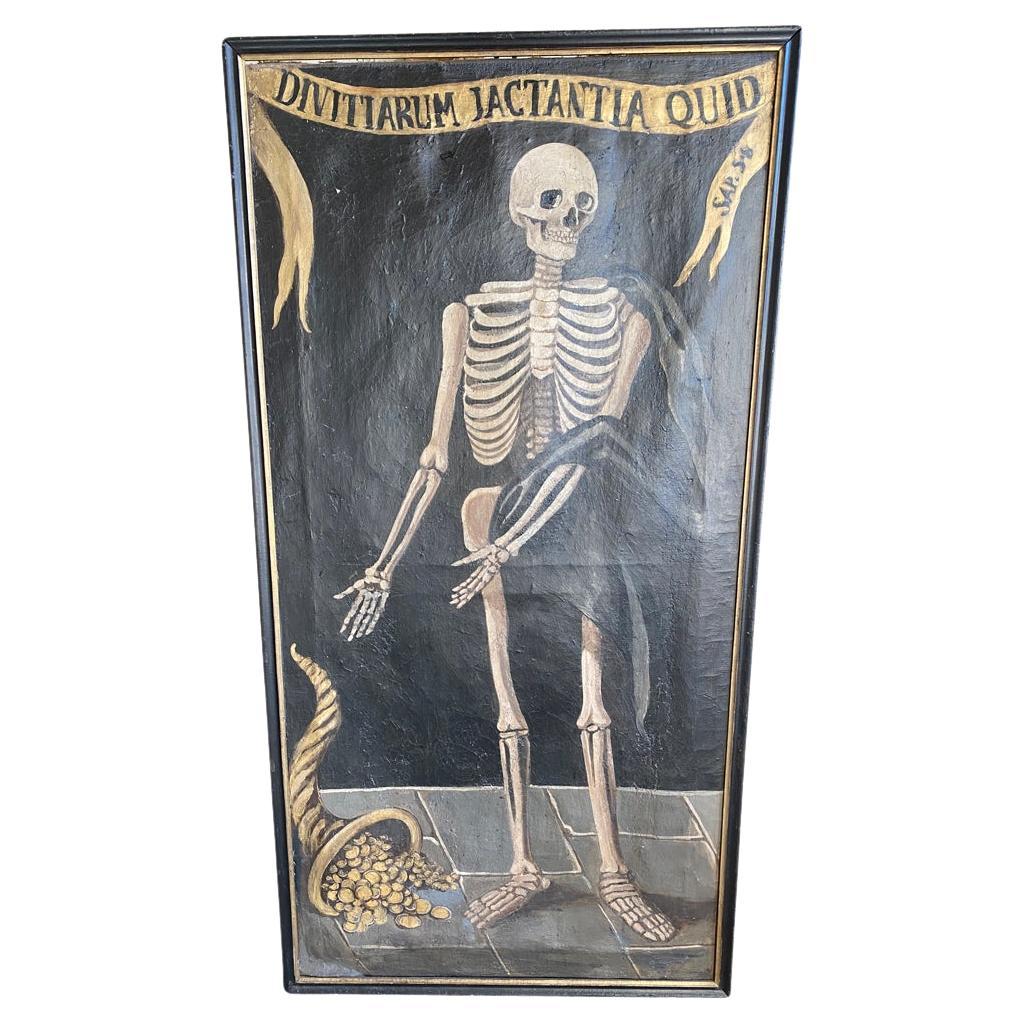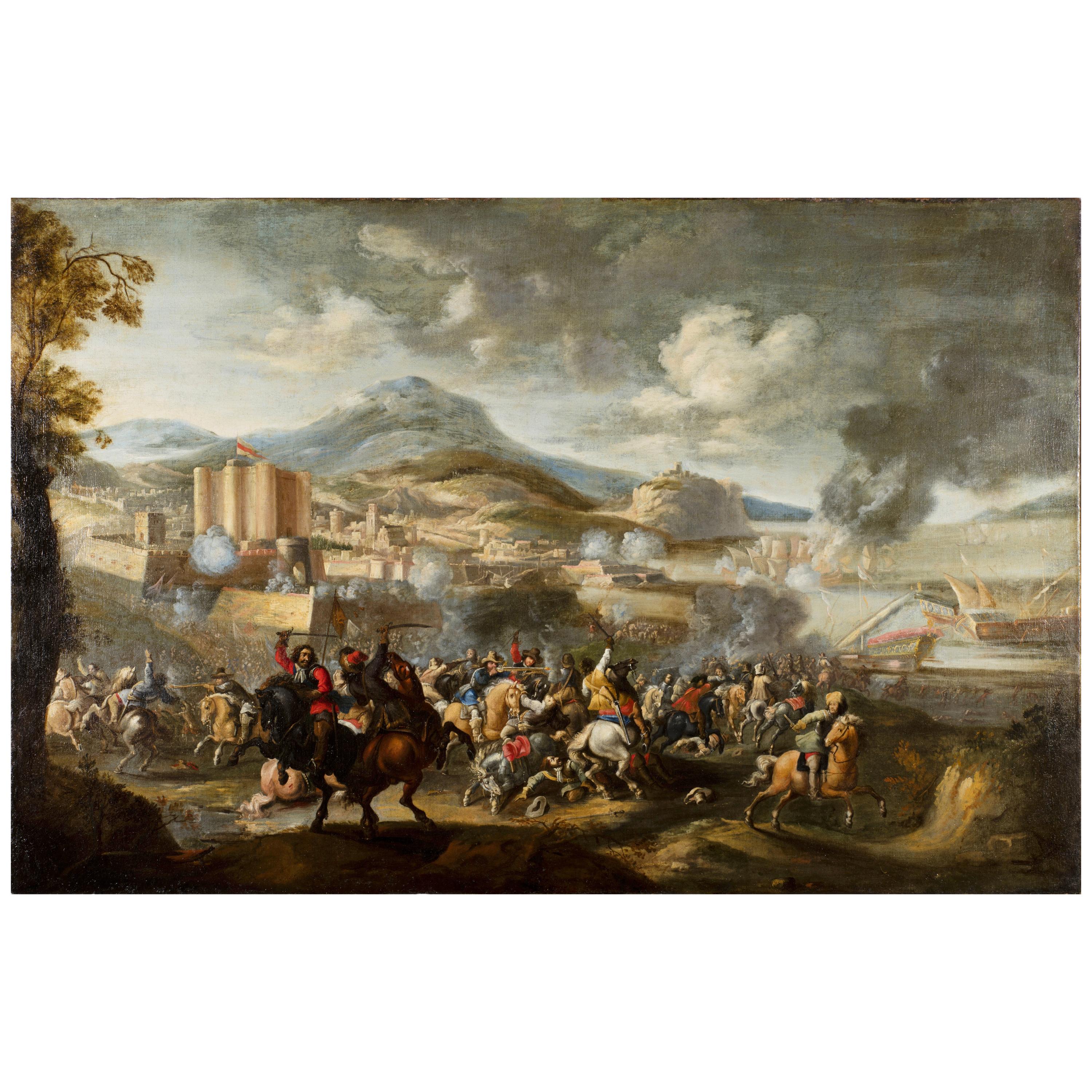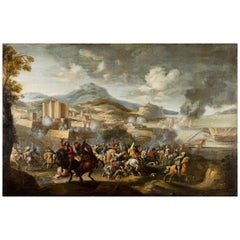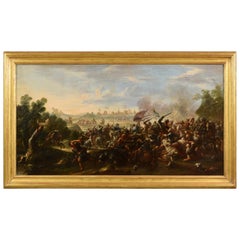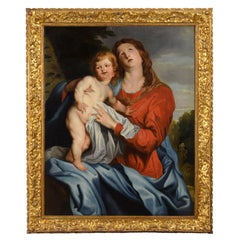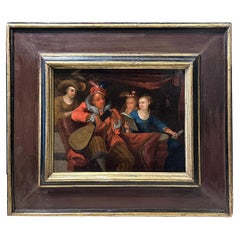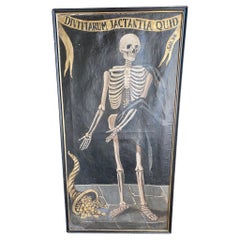Items Similar to 17th Century, Italian Painting with Saint Cecilia with Angels in Concert
Want more images or videos?
Request additional images or videos from the seller
1 of 9
17th Century, Italian Painting with Saint Cecilia with Angels in Concert
About the Item
17th century Roman school, Santa Cecilia with angels in concert, oil painting on canvas
The valuable painting, in excellent condition, depicts Saint Cecilia playing the organ, surrounded by cherubs and cherubim. The saint, with an absent gaze and turned towards a mystical and divine light that transpires from behind the pipes of the organ and soft clouds, is dressed in refined and precious silk dresses. Next to her a putto hands her the musical score. The structure of the organ and the chair, in carved wood, reflect the stylistic dictates widespread in Rome in the Baroque era. The pavement in checkered, distorted prospectively, invites the observer’s gaze to converge towards the center of the canvas, where the face of the saint is represented. In the background, two imposing marble columns and a rich curtain frame the scene and serve as a fifth, increasing the compositional solemnity.
The author of the canvas is to be found in a painter active in Rome in the seventeenth century of skilled technical and compositional skills. The composition, played mainly in shades of brown, blue green and red, is harmonious and beautiful balanced. The natural rendering of silk fabrics, as well as of the skin tones, is proof of a high pictorial skill.
Iconographically, Saint Cecilia is often depicted playing an instrument and her image is often an allegory of Music itself, included in the Liberal Arts Quadrivium.
Cecilia was a Roman noblewoman, hence the sumptuous and rich clothing, lived between the second and third centuries. A.a. She was married to Valerian, also a descendant of a noble Roman family. On the night of the wedding, Cecilia revealed to her husband her conversion to Christianity and her decision to take a vow of chastity. The husband accepted his wife’s wish, converted himself to Christianity and had his brother Tiburzio converted as well.
All three thus began a work of spreading the new religion and Cecilia, excellent speaker, soon managed to convert many Romans, protected and helped by the two brothers soldiers. For their charitable activities, their fame grew so fast that they were condemned to martyrdom by the Roman prefect Turcio Almachio. Saint Cecilia is known to be the patron saint of music. His approach to this art was generated by an incorrect interpretation of the texts of the antiphonaries that were used in the masses during the celebrations for the saint.
The original text reads as follows: "Candentibus organis, Caecilia virgo in corde suo soli Domino decantabat.", that is "Among the organs (instruments of martyrdom) glowing, the virgin Cecilia sang praises to God in her heart". The wrong interpretation is in the first sentence, transcribed as follows, "Cantantibus organis" or "Among the organs(musical instruments) playing", therefore listening to heavenly music sang praises to God in his heart.
Thus begins, from the fifteenth century, the iconographic fortune of Cecilia, to whom were attributed musical abilities. Thus, the saint was given a portative organ as a symbol of her excellent skills as a musician and since then she has been invoked by singers and composers as their protector.
Art history studies are currently underway.
- Dimensions:Height: 49.61 in (126 cm)Width: 40.56 in (103 cm)Depth: 3.15 in (8 cm)
- Style:Baroque (Of the Period)
- Materials and Techniques:
- Place of Origin:
- Period:
- Date of Manufacture:17th Century
- Condition:Refinished. Wear consistent with age and use.
- Seller Location:IT
- Reference Number:1stDibs: LU4405232769182
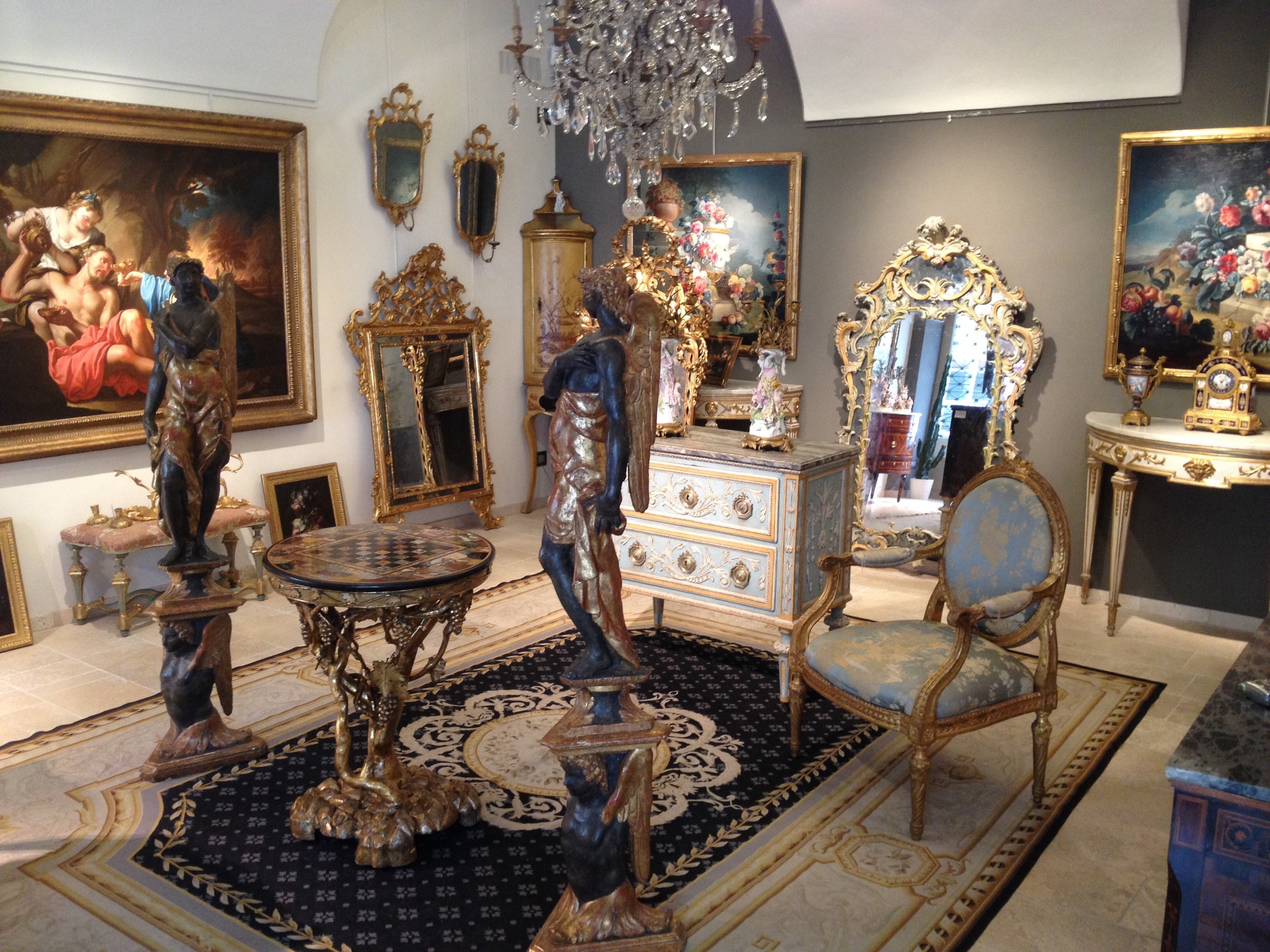
About the Seller
5.0
Vetted Seller
These experienced sellers undergo a comprehensive evaluation by our team of in-house experts.
Established in 1980
1stDibs seller since 2019
44 sales on 1stDibs
Typical response time: 3 hours
- ShippingRetrieving quote...Ships From: Italy
- Return PolicyA return for this item may be initiated within 7 days of delivery.
Authenticity Guarantee
In the unlikely event there’s an issue with an item’s authenticity, contact us within 1 year for a full refund. DetailsMoney-Back Guarantee
If your item is not as described, is damaged in transit, or does not arrive, contact us within 7 days for a full refund. Details24-Hour Cancellation
You have a 24-hour grace period in which to reconsider your purchase, with no questions asked.Vetted Professional Sellers
Our world-class sellers must adhere to strict standards for service and quality, maintaining the integrity of our listings.Price-Match Guarantee
If you find that a seller listed the same item for a lower price elsewhere, we’ll match it.Trusted Global Delivery
Our best-in-class carrier network provides specialized shipping options worldwide, including custom delivery.More From This Seller
View All17th Century, Italian Painting with Battle attributed to Marzio Masturzo
Located in IT
Marzio Masturzo, attributed (Active in Italy - in Naples and Rome- in the second half of the 17th century)
"Battle between cavalry and vessels with fortified city on the left"
...
Category
Antique Late 17th Century Italian Baroque Paintings
Materials
Canvas
17th Century, Italian Painting with Still Life with Fruit, Dogs and Cat
Located in IT
17th Century, Italian painting with still life with fruit, dogs and cat
Measurements: With frame cm W 93 x H 75.5 x D 4; Frame cm W 82.5 x H 66.5
The...
Category
Antique 17th Century Italian Baroque Paintings
Materials
Canvas
17th Century, Italian Painting with Battle Between Christian and Turkish Cavalry
Located in IT
17th century, Italian oil on canvas painting with battle between Christian and Turkish cavalry
The oil on canvas painting depicts a battle between Christian and Turkish cavalry. C...
Category
Antique Mid-17th Century European Baroque Paintings
Materials
Canvas
17th Century, Italian Painting with Virgin and Child by Follower of Van Dyck
By Anthony van Dyck
Located in IT
17th century, Italian painting with virgin and childr by Follower of Sir Anthony van Dyck
cm W 90 x H 113; cornice cm W 111 x H 135 x D 7
The canvas depicts the Madonna with the Chi...
Category
Antique Late 17th Century Italian Baroque Paintings
Materials
Canvas
17th Century, Italian Painting by Pier Francesco Cittadini, Jacob and his Family
Located in IT
Pier Francesco Cittadini (Milan, 1616-Bologna, 1681)
"Jacob and his family go to Egypt"
Oil on canvas, cm 109 x 190 (canvas only)
The valuable painting, made in oil on canvas, depicts Jacob and his family go to Egypt and we believe it can be, given the high quality painting, autograph work of Italian Pier Francesco Cittadini (Italy Milan, 1616 - Bologna, 1681) made after 1647. The work, in excellent condition is accompanied by a coeval frame in wood finely carved and golden.
The scene depicted, which was confused with the Flight to Egypt in the past years, is instead identified with the biblical episode of Jacob’s journey. In the foreground, reading the painting from left to right, we see a caravan composed of animals, including donkeys, dromedaries, goats, dogs and horses and people, women, men and slaves, who carry on their journey along the banks of a river, following a path that to the right, would seem to lead to the through of a bridge. In addition to the watercourse is described an environment characterized by large rocks and impervious come far to cover the entire verticality of the canvas. On the left, in the distance, we see the tail of the caravan that runs along the steep path. Large trees enliven and harmonize the environment, as well as white and grey clouds characterize the predominantly clear sky and illuminated on the right by sunlight.
The story is told in the Bible, Book of Genesis, 30, 25, passage in which is described the flight of Jacob from Haran after the contrasts with Laban, father of his wife Rachel. Jacob is the third great patriarch of the Bible. From his descendants originate the twelve generations of the people of Israel. He is the son of Isaac and Rebekah, who led him to flee from the wrath of Esau to Haran to seek refuge from his brother, Laban. At his uncle’s house Jacob met his daughter Rachel. As soon as he saw his cousin, Jacob was taken. Jacob will stay seven years in the service of Laban to marry his beloved Rachel. But Laban, with a deception, will give him in marriage first Lia, the least beautiful eldest daughter, and only after another seven years the splendid Rachel. From his first wife he will have several children, while Rachel will give birth to the beloved son, Joseph, who will become viceroy of Egypt.
After years of service, Jacob asked to be paid with every dark-coloured garment among the sheep and every spotted and dotted garment among the goats. Laban accepted and sent away from his sons all the leaders of that kind. So Jacob took fresh branches of poplar, almond and plane tree, and flayed them, and put them in the troughs. The optical suggestion induced the goats and the sheep to conceive and give birth to dark, striped and dotted garments. He also ensured that all the strongest and healthiest leaders of the flock of Laban would drink near the barked branches, thus assuring a genetic superiority to his part of the flock. His flocks grew numerous and strong and he became richer than his relative, arousing envy. It was clear that Laban would not respect him much longer. At the suggestion of the Lord, Jacob decided to return to Canaan. Trying to avoid any possible dispute, he left with his family while Laban was absent for shearing sheep. But when, three days later, his uncle returned home, he became angry, feeling offended because Jacob had gone secretly and had not allowed him to greet his daughters and grandchildren. In addition, his teraphim, statuettes, or idols, which depicted the family deities, had disappeared. After 7 days of pursuit, Laban and his men reached Jacob’s group on Mount Gilead, in the mountainous region west of the Euphrates River, where his uncle and grandson had a stormy conversation. The younger man was outraged at being accused of stealing idols and told Labano to rummage through his family’s tents at will. Neither of them could know or even imagine that it was Rachel who took the idols and hid them in the saddle of the camel. During the search, she sat down firmly on the saddle, apologizing for not being able to get up, «because I usually have what happens to women» (Gen 31:35). So the loot wasn’t discovered.
The author of this work was inspired by the composition of an engraving by Stefano Della Bella (1610-1664) of circa 1647. The engraving by Stefano della Bella bears the title "Iacob sur ses vieux jours quitte sans fascherie pour voir son filz Ioseph, sa terre et sa patrie" and is signed on the bottom left "Stef. of the Beautiful In. et fe." while on the right it is declared "Cum privil. Regis", that is with license of the king.
Stefano Della Bella (Italy - Florence, May 18, 1610-Florence, July 12, 1664) was born in a family of painters, sculptors and goldsmiths and was left early orphan of his father sculptor, he dedicated himself first to the art of goldsmith at the school of Giovanni Benedetto Castiglione and Gasparo Mola, then turning his attention to drawing and engraving. He soon began drawing figures and copying the etchings of Jacques Callot, which inspired his early works. Under the protection of the Medici, in particular of Don Lorenzo, cadet son of Grand Duke Ferdinand I, Della Bella has the opportunity to make study trips to Rome, where he stayed from 1633-1636; In Rome he met French engravers and publishers of prints such as Israël Henriet and François Langlois, who influenced his decision to move to Paris in 1639, four years after the death of Callot. In Paris he soon reached, thanks to the engravings commissioned by Cardinal Richelieu, the success also worldly; he frequented courtiers, theatre artists and writers, while refusing too oppressive honors. In 1646-1647 he continued his travels in the Netherlands to Amsterdam, Antwerp and Dordrecht. He returned to Florence in 1650 and resumed working under the protection of the Medici court, working for his patrons. In 1656 he became a member of the Academy of Apatists.
The painting object of this study is reasonably attributable to Pier Francesco Cittadini, or Pierfrancesco Cittadini, called the Milanese or the Franceschino (Italy - Milan, 1616-Bologna, 1681) as some exemplary stylistic comparisons proposed to follow can prove.
Pier Francesco Cittadini was an Italian baroque painter, mainly active in Bologna.
His artistic training first took place with the painter Daniele Crespi...
Category
Antique Mid-17th Century European Baroque Paintings
Materials
Canvas, Giltwood
17th Century, Italian painting Allegory of the Spring Follower of Jacopo Bassano
By Jacopo Bassano
Located in IT
Follower of Jacopo Da Ponte, called Jacopo Bassano (Bassano del Grappa, circa 1510 - Bassano del Grappa, 13 February 1592), 17th century
Allegory of the Spring
Measures: With frame: ...
Category
Antique Late 17th Century Italian Baroque Paintings
Materials
Canvas
You May Also Like
17th CENTURY PAINTING WITH PARTY AND CONCERT IN A PALACE
Located in Firenze, FI
This fascinating painting, made with oil tempera on walnut tablet and framed in a thick frame, represents a lively scene of celebration and concert in the palace. At the center of th...
Category
Antique 17th Century Italian Paintings
Materials
Wood, Paint
17th Century Old Master Death of Saint Cecilia
Located in Nottingham, GB
In good condition
From a private collection
Free international shipping
17th Century Old Master Death of Saint Cecilia
Category
Antique 17th Century Paintings
Materials
Paint
17th Century Painting
Located in Miami, FL
17th century painting
J.Castano
17th century
Spain
Category
Antique 17th Century Baroque Paintings
Materials
Canvas
$25,000
17th Century Italian Oil Painting
Located in Atlanta, GA
An intriguing Italian 17th century oil on canvas painting. A skeleton with a cornucopia of gold pieces. Divittarum Jactantia Quid - "What is the boasting of the rich?".
Category
Antique 17th Century Italian Paintings
Materials
Canvas
17th Century Italian School "Saint Joseph and the Child"
By Midcentury Italian school
Located in Madrid, ES
17th Century Italian School
"Saint Joseph and the Child"
oil painting on canvas
95cm x 67cm measures without frame
frame size: 10cm
good conditions
golden frame
Private Italian Colle...
Category
Antique 17th Century Italian Baroque Paintings
Materials
Paint
Italian School "Apostle" 17th Century
By Europa Antiques
Located in Madrid, ES
Italian School
"Apostle" 17th Century
Oil on oak wood
Carved and gilded wooden frame.
Small defects.
Dim.: 44 x 58 cm
good conditions
Category
Antique 17th Century Italian Baroque Paintings
Materials
Paint
Recently Viewed
View AllMore Ways To Browse
Chair With Carved Face
Hand Painted Carved Saint
Husband And Wife Oil Painting
Roman Baroque Painting
Antique Heart Chair
Black Column Dress
Cherub Oil Painting
Cherubs Oil Painting
17th Century Wood Chairs
Blue Wedding Dress
Cherub Cloud
Musical Cherubs
Green Silk Chair
Antique Face Chair
His And Her Chairs Antique
Putto Marble
Italian Wood Carved Cherubs
Checker Dress
